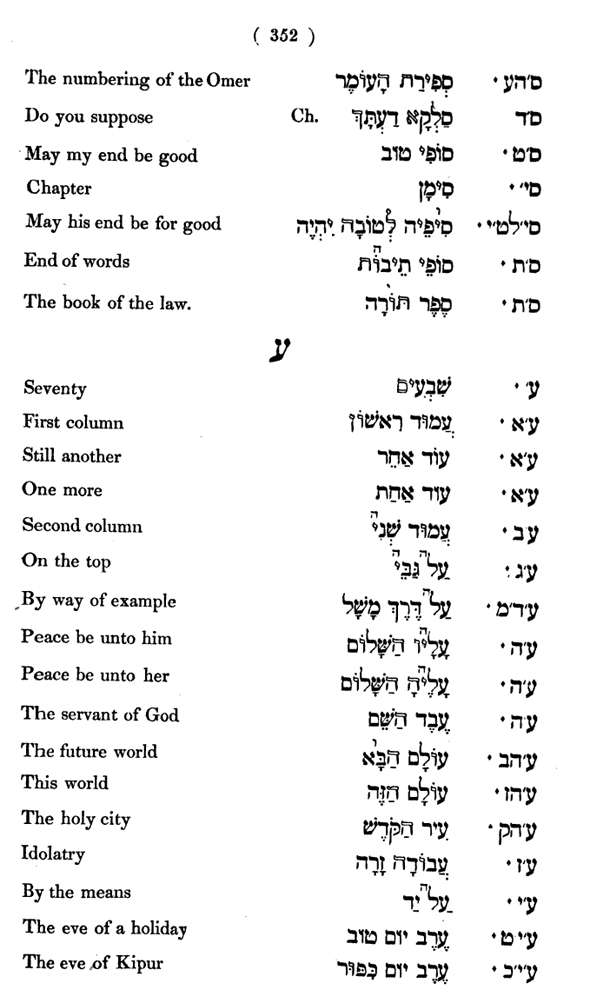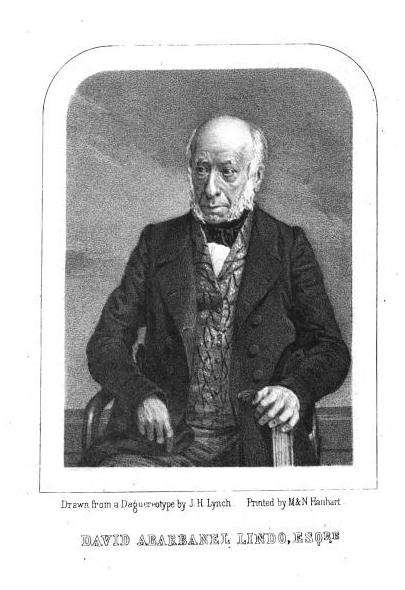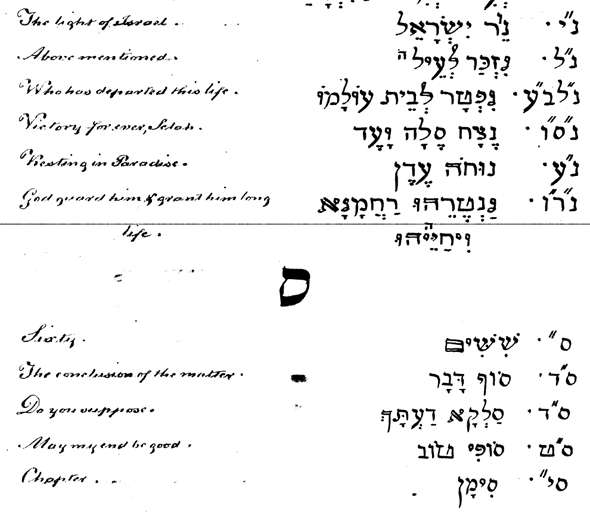
This page is from Abigail Lindo's (1803-1848) Hebrew and English and English and Hebrew dictionary: with roots and abbreviations, which was very modestly "Not Published" in London in 1846, according to the title page, in which she also names herself Abigail third daughter of David Abarbanel Lindo, Esq., much as any pious author does (give the greater honor to their father than to their own name). This is, in fact, the third, twice enlarged edition of her book, which was first printed in 1837.
As you can see, detail below, she employed the very same technique used by Elias Hutter in his Bible "that can teach you Hebrew," as I called it here. That is, he used a hollow font to differentiate between the stems and roots of Hebrew words with the result that the reader could automatically know a great deal about the construction of each word as they read it. As she puts it in the introduction, "The hollow letters indicate the serviles, the others form the root; whilst the small letters placed over a word must be added to complete the root." Compare:


For some strange reason this only appears in her section on abbreviations, rather than in the dictionary proper. My guess is . . . cost? She does not say. In the intro she further thanks her "revered father," as well as the Haham Rev. Dr. D. Melodla, who gave her information for which she is grateful. The book (not published, mind you) is dedicated to her cousin Sir Moses Montefiore, and includes an engraving of her father, looking positively Dickensian (and I don't mean a Dickensian Jew ala Fagin).

David Abarbanel Lindo (1765-1851) was a mohel, and he performed the bris milah on his nephew Benjamin Disraeli in 1804 (born D'Israeli and, well, an Israelite). As Lucien Wolf elegantly put it, "It was David Abarbanel Lindo who performed on Lord Beaconsfield the ceremony of initiation into the Covenant of Abraham"
In his daughter's dictionary proper, there is a wonderful technique, which is to place the roots of each word in a clear and sensible way right next to each entry. Here's a representative example - representative not only of the technique, but also her many compound word neologisms, included no doubt so that the student can learn to make Hebrew a contemporary, flexible language:

In a similar vain, the better-known and more forthright young English Jewish authoress Grace Aguilar wrote the following hopeful prediction, in 1845:
". . . if we can but establish in every land a vernacular Jewish press, it will work more and more. The grammatical study and acquirement of our own noble language, the Hebrew, which is now made part of the education of every Hebrew child, will forward this glorious end. The light is dawning over many lands, but a faint, faint streak indeed, but enough to promise, for God himself has said it, that it will "brighten more and more into the perfect day,"and permit "the Sun of [Righteousness" to rise and shine on all the nations, as the light of heaven on the earth. Ages may pass, indeed, ere this will be, but man has power of progression in himself, and Will attain it."
As it happens, a manuscript of this wonderful work is online, thanks to the JTS Library and hebrewbooks.org (via hebrewmanuscripts.org). I don't know if this is in her own hand or not. But as you can see, even in manuscript the method of hollow letters was used, so perhaps my earlier conjecture about cost of printing was premature. Maybe the intention was that it would be too distracting to be used throughout.

Someone should compare the book and the manuscript. I noticed that at least some of the material was nor printed. For example, the manuscript entry for the abbreviations beginning with the letter פ contains no less than two entries which did not make it into print, and I assume there are many more:

The first one - פירשי, or "the author Solomon Jarchi explains," is interesting because of how she vocalizes Rabbi Shlomo - רַבִּי שֶׁלֹמֹה - It uses the very un-Sephardic vocalization of רבי with a patach, which I think is more a tribute to 18th and 19th century Hebrew grammatical scholarship than the fact that Rashi was an Ashkenazi (yes, I know that's irrelevant historically for this vocalization). Next, she put a seghol rather than a sheva under the ש, which I tend to think is a minor mistake, influenced by her Sephardic pronunciation.





It's also interesting because the Hebrew says "Yitzchaki" while the English says "Jarchi".
ReplyDeleteTrue. For the time that would be like translating רמב"ם as Maimonides.
ReplyDeleteAlso interesting is her entry "samekh-tet/sofi tov." Ms. Lindo and her sources were thus impliedly rejecting the view that this abbreviation stood for "Sefaradi Tahor."
ReplyDeleteDan, you'll find a lot about this online, and Sefardi Tahor is clearly disproved (though if this is how people use it today, it's correct, of course).
ReplyDeleteAlmost every 19th century Sefardic source defining the abbreviation that I've seen - these from people with a living tradition of its usage - defines it סופי טוב or something very much like it. And, yes, I chose this random sample not so randomly. ;)
ReplyDeleteSee here
http://onthemainline.blogspot.com/2009/09/clearing-up-50-year-old-herman-wouk.html
and here, where I show that the alternate reading might be justified from a late 18th century source, although it is possible that it is actually a separate, unrelated acronym
http://onthemainline.blogspot.com/2009/06/contribution-to-st-acronym-debate.html
and also a letter from Isaac Samuel Reggio (Yashar) to Ignaz Blumenfeld, published in Otsar Nechmad 1 (1856), letter 11, page 34.
נהגו חכמי איטליאה לכתוב אחר שמותם תיבת ס”ט ופירושם סופו טוב להיות להם לסימן יפה שסיימו בטובה
For him it certainly was a living tradition. His father, for example, who was born in 1755 and used ס”ט.
Wow, still סיפיה טב in the 19th century -- really that late! I find that interesting, since I know people alive today whose grandfathers used it in the 1930s as ספרדי טהור.
ReplyDeleteI think a great contribution to the discussion would be to document the change, when, where, why - or if indeed it was a change, and there weren't two traditions.
ReplyDeleteFrom where did your friend's grandfathers stem? I have some hunches, but I want to know this first.
http://seforim.blogspot.com/2007/09/marc-shapiro-what-do-adon-olam-and-mean.html
ReplyDeleteS. -- Haketia-speaking community of Morocco. Moved to Spain some time in the mid-twentieth century (1930s? 1940s? No later than 1950s.)
ReplyDeleteI have another friend whose grandfather signs his name ס"ט today. He was born in Turkey, but I don't know when he started using this signature with this meaning.
ReplyDeleteI came across an interesting little JTS piece from 1978 called "The Downgrading of Culture," where an Israeli novelist (Aharon Megged) got all preachy against Anglo Jewry for its lack of culture, especially Hebrew culture. He said that this portended the community's "degeneration." A quote from the bottom:
ReplyDelete>The cultural decline of Anglo-Jewry had been going on for more than a century, he believed. For example, how many people knew that the first attempt to restore Hebrew as a modern, spoken language was made in England? More than half a century before the famous Eliezer Ben Yehuda, an English Jew, Abigail Lindo (1803-1848), had written a dictionary and a Hebrew discussion book which was still usable.
>The fact that so few English Jews had even heard of this woman was another sign of their cultural degeneration, Megged concluded.
Mar G,
ReplyDeleteJust thinking out loud. You have an Italian Sefardi (Reggio) and an English one (Lindo) writing that it's sofi tov. On the other hand, you have Moroccan and Turkish Sefardim (the grandfathers) saying or thinking that its Sefardi Tahor. Perhaps there is some reason why European Sephardim did not feel the need to see the acronym as pointing to their pure Sefardic heritage.
On the other hand, as has been widely pointed out, Chacham Tzvi (and sometimes his son) used s"t," and Chacham Tzvi's Sephardic cultural exposure was in Belgrade, which should be similar to Turkey. This may only mean that he, as a careful, learned scholar, knew what the acronym really meant, while the hamon am didn't - assuming your friend's grandfathers were hamon amim. Maybe it even arose at a later date, once there was more contact with Europeans and these Sefardim felt a need to assert a high cultural heritage - to keep up - that they hadn't before.
I might add that Edrehi, whom I also linked to, was Moroccan, and he did not understand it as Sefardi Tahor - unless Sy"T was not the same as S"T to him.
ReplyDeleteAnother possibility is that those of real or imagined Spanish heritage thought it meant Sefardi Tahor, while those who were not, obviously didn't. Edrehi may not have been of Spanish descent.
All interesting thoughts! Thanks!
ReplyDelete" 'For example, how many people knew that the first attempt to restore Hebrew as a modern, spoken language was made in England? More than half a century before the famous Eliezer Ben Yehuda, an English Jew, Abigail Lindo (1803-1848), had written a dictionary and a Hebrew discussion book which was still usable.' "
ReplyDeleteMegged's comparison of Ben Yehuda's work with Lindo's, in the JTS piece, is manifestly absurd. Its a good example of what happens when one allows ideology to get in the way of judgment, and strains to over-inflate the accomplishments of women.
JTA (my mistake), and I can assure you there was no feminist ideology here. The ideology is Zionist. It was the only way for him to say "British Jews, you suck. You didn't used to, but you do now."
ReplyDeleteStrictly speaking, I don't think Reggio or the "hakhmei Italia" that he cites ought to be considered "Sefardi," tahor or otherwise. Most likely he (and they) belonged to that segment of Italian Jewry that identified itself as neither Ashkenazi nor Sefardi but just Italian. If so, their use and understanding of s"t would militate all the more strongly against "Sefaradi Tahor" as the original or "proper" meaning.
ReplyDeleteWhy do you say that? Granted, I never examined his lineage, but a lot of people assume that the Luzzattos were Sefardi, or Italki, but they were Ashkenazi - to the point that as late as Shadal's time, his personal minhag was Ashkenaz.
ReplyDeleteHowever, you're right that if native Italians used it too that would be an additional piece of evidence.
The Ashkenazi component of Italian Jewry typically had surnames that were modified from German, like Luzzatto (from Lausatz) or Morpurgo (from Marburg). The Italian Sefardim tended to keep their Spanish or Moroccan names, like Pardo or Benamozegh. But those whose family names were taken from Italian cities, such as Reggio, Ancona, Bertinoro, Modena, etc., were (as far as I know) Italkim.
ReplyDelete